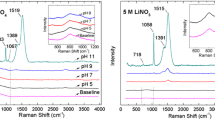Anodic processes on aluminum used as a current collector in electric double-layer capacitors in a 0.1 M solution of tetraethylammonium tetrafluoroborate in acetonitrile are studied to determine its corrosion resistance. It is shown that aluminum can be anodically dissolved in an aprotic electrolyte of a supercapacitor with formation of electroconductive films on its surface.
Similar content being viewed by others
References
B. Conway, Electrochemical Supercapacitors: Scientific Fundamentals and Technological Applications, Kluwer–Plenum, New York (1999).
C. Peng, L. Yang, Z. Zang, K. Tachibana, and Y. Yang, “Anodic behavior of Al current collector in 1-alkyl-3methylimidazolium bis[(trifluromethyl)] sulfonyl] amide ionic liquid electrolytes,” J. Power Sources, 173, 510–517 (2007).
M. A. Amin, S. S. Abd El-Rehim, E. E. F. El-Sherbini, et al., “Pitting corrosion studies on Al and Al–Zn alloys in SCN− solutions,” Electrochim. Acta, 54, 4288–4296 (2009).
V. V. Skopenko and V. Ya. Zub, Coordination Chemistry. Tutorial [in Ukrainian], Kyiv University, Kyiv (2002).
S. S. Zhang S. S. and T. R. Jow, “Aluminum corrosion in electrolyte of Li-ion battery,” J. Power Sources, 109, 458–464 (2002).
N. M. Gontmakher, V. I. Naumov, L. M. Astakhova, et al., “Investigation of the surface characteristics in the dissolution of aluminum in fluoride-containing media,” Élektrokhimiya, 29, No. 6, 791–793 (1993).
F. Toshikiko, “Reliability, performance and safety,” in: Proc. of the 2nd Int. Symp. on Large Ultracapacitor (EDLC) Technology and Application (May 16–17, 2006, Baltimore, Maryland), Baltimore (2006), pp. 12–16.
P. Kurzweil and M. Chwistek, “Electrochemical stability of organic electrolytes in supercapacitors: Spectroscopy and gas analysis of decomposition products,” J. Power Sources, 176, 555–567 (2008).
P. Kurzweil, M. Chwistek, and R. Gallay, “Capacitance determination and abusive aging studies of supercapacitors based on acetonitrile and ionic liquids,” in: Proc. of the 16th Int. Sem. on Double Layer Capacitors and Similar Energy Storage Devices (December 4–6, 2006, Deerfield Beach, Florida) (2006), pp. 78–92.
Author information
Authors and Affiliations
Corresponding author
Additional information
Translated from Fizyko-Khimichna Mekhanika Materialiv, Vol. 46, No. 3, pp. 120–125, May–June, 2010.
Rights and permissions
About this article
Cite this article
Hromads’kyi, D.H., Fateev, Y.F., Stryzhakova, N.H. et al. Anodic processes on aluminum in aprotic electrolytes based on the tetraethylammonium tetrafluoroborate salt in acetonitrile. Mater Sci 46, 412–417 (2010). https://doi.org/10.1007/s11003-010-9305-1
Received:
Published:
Issue Date:
DOI: https://doi.org/10.1007/s11003-010-9305-1




